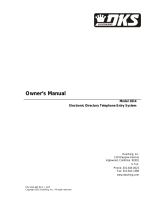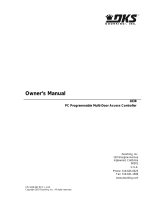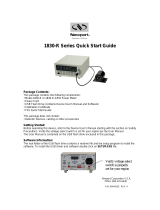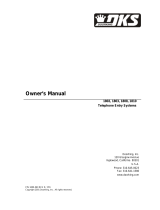
1835-065-H-7-19
3
FCC – United States
This equipment has been tested and found to comply with the limits for a class A digital device, pursuant to Part 15 of the FCC Rules and
Regulations. These limits are designed to provide reasonable protection against harmful interference when the equipment is operated in a
commercial environment. This equipment generates, uses, and can radiate radio frequency energy and, if not installed and used in accordance
with the instruction manual, may cause harmful interference to radio communications. Operation of this equipment in a residential area is
likely to cause harmful interference in which case the user will be required to correct the interference at his own expense.
FCC Registration Number: DUF6VT-12874-OT-T
DOC - Canada
The Canadian Department of Communications label identifies certified equipment. This certification means that the equipment meets certain
telecommunications network protective, operational, and safety requirements. The Department does not guarantee the equipment will operate
to the users satisfaction.
Before installing this equipment, users should ensure that it is permissible to be connected to the facilities of the local telecommunications
company. The equipment must also be installed using an acceptable means of connection. The customer should be aware that compliance
with the above conditions may not prevent degradation of service in some situations.
Repairs to certified equipment should be made by an authorized Canadian maintenance facility designated by the supplier. Any repairs or
alterations made by the user to this equipment, or equipment malfunctions, may give the telecommunications company cause to request the
user to disconnect the equipment.
Users should ensure, for their own protection, that the electrical ground connections of the power utility, telephone lines, and internal metallic
water pipe system, if present, are connected together. This precaution may be particularly important in rural areas.
CAUTION: Users should not attempt to make such connections themselves, but should contact the appropriate electric inspection authority, or
electrician, as appropriate.
DOC Registration Number: 1736 4507 A
Notice:
The Load Number (LN) assigned to each terminal device denotes the percentage of the total load to be connected to a telephone loop which is
used by the device, to prevent overloading. The termination on a loop may consist of any combination of devices subject only to the require-
ment that the sum of the load numbers of all the devices does not exceed 100.
Notice:
DoorKing does not provide a power transformer on units sold outside of the United States. Use only transformers that are listed by a
recognized testing laboratory to power the telephone entry system. An Inherently Protected Transformer must be used to power this device.
1833, 1834 and 1835 systems require a 16.5-volt, 20 VA transformer. The model 1837 requires a 16.5-volt, 40 VA transformer.
Listing:
This product has been tested to and found to be in compliance with the UL 294 Safety Standard and Certified to CAN/ULC-S319-05 by Intertek
Testing Services NA Inc. (a Nationally Recognized Testing Laboratory) and is ETL listed.
ACCESS CONTROL SYSTEM: A collection of means, measures and specific practices that when combined, form or compose a systematic
approach, which enables an authority to control access to areas and resources in a given physical facility. An access control system, within
the field of physical security, is generally seen as the second layer in the security of a physical structure.
ALARM: A condition indicating a state of alert or tamper detection.
ALARM SIGNAL: A transmission of an alarm condition or alarm report.
CONTROLLED AREA: A room, office, building, facility, premises, or grounds to which access is monitored, limited, or controlled.
EQUIPMENT: Any part of an electronic access control system, such as access control units, reader interface modules, access point actuators,
access point sensors, keypads, and the like.
PROTECTED AREA: A room, office, building, facility, premise or grounds to which access is monitored, and limited and/or controlled,
whereby the authorized person of the Access Control System may grant access to non-authorized persons.
RESTRICTED AREA: A room, office, building, facility, premise or grounds to which access is monitored, and limited and strictly controlled,
whereby only the administrator of the Access Control System shall issue credentials that will lead to access.
Important Notices
Glossary
Performance Levels
Destructive Attack: Level I (Level II with Optional Hood Installed)
Line Security: Level I
Endurance: Level IV
Standby Power: Level I (Level II with 12 VDC, .7 Ah, SLA battery, required
Single Point Locking Device with Key Locks: Level I
for Canadian certification)























